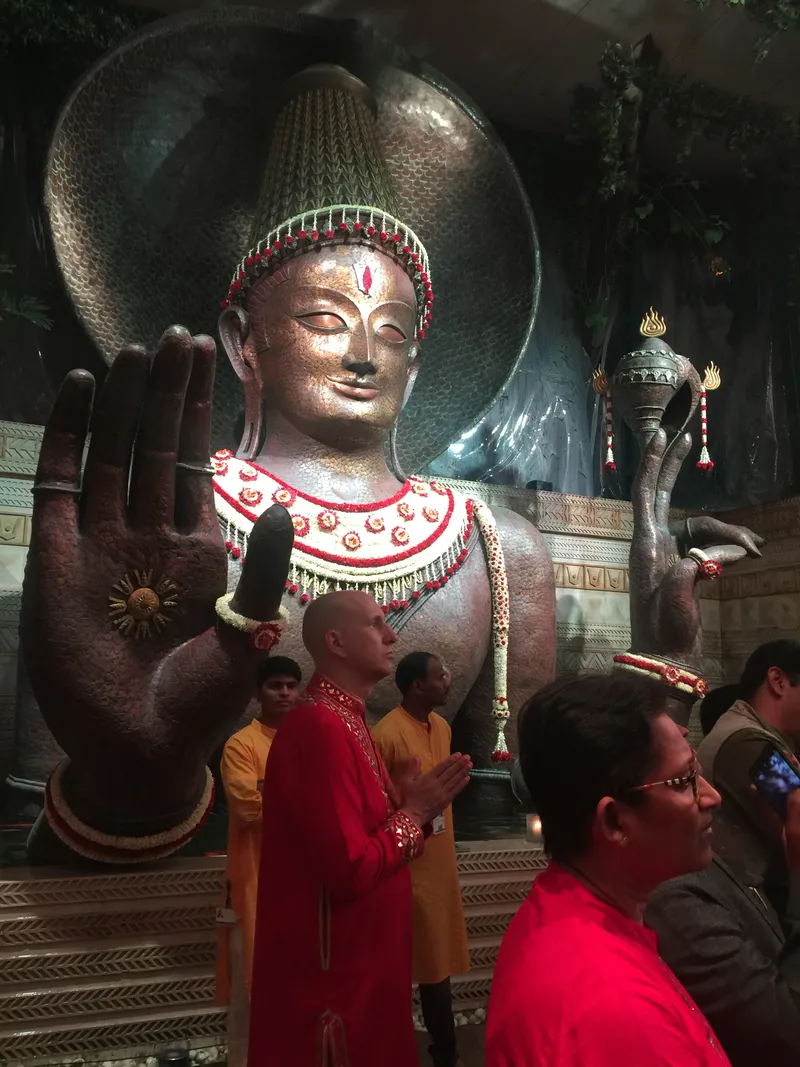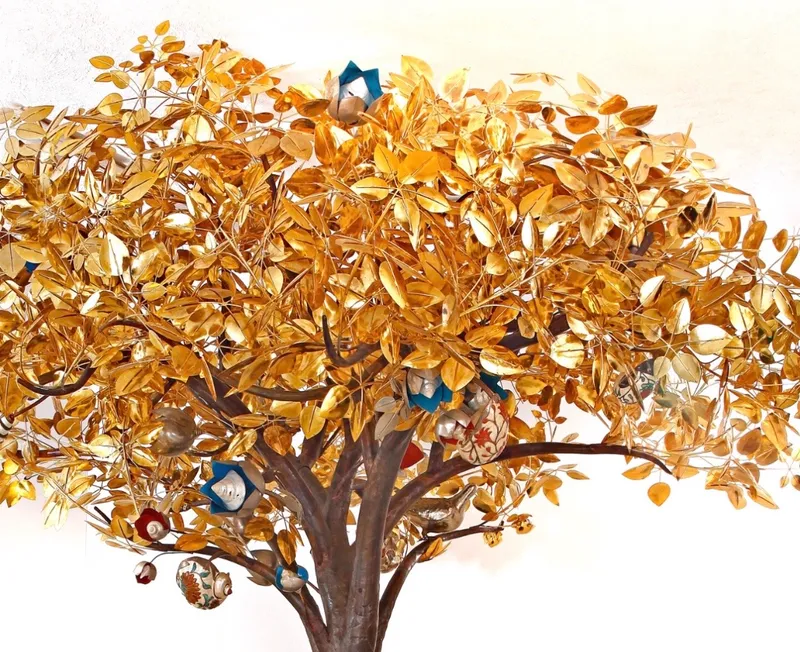Inside the mind of Satish Gupta: The artist who created art for PM Modi, Nita Ambani
With a deeply rooted spirituality and Zen philosophy, artist Satish Gupta talks about his creative process, and creating a masterpiece that almost made him blind.
Celebrated artist Satish Gupta created his first major sculpture—a 12-foot head of Shiva titled Kalyansundara—in 2007.
“The Shiva sculpture is a Swayambhu, a self-created work. I genuinely believe that the sculpture created itself through me, but the intensity of the energy involved in its creation was overwhelming—so much so that I nearly lost my eyesight during the process,” Gupta tells YS Life.
While the sculpture was purchased by a private collector, Gupta wanted it to be seen by a wider audience. He created a book, Centering Awareness, featuring interpretations of the sculpture by various photographers, and essays from writers and critics.
The manuscript of the book, along with the sculpture, was displayed at the Jehangir Art Gallery in Mumbai, before being showcased across cities.
It was during this exhibition that Gupta met Nita Ambani, Founder and Chairperson of the Reliance Foundation.

Satish Gupta, accomplished artist, painter, poet, writer, printmaker, muralist, designer, calligrapher and ceramicist
“She purchased several paintings from the exhibition and asked me to install them at Nariman Point. She also mentioned having heard a lot about the Shiva sculpture and expressed a strong desire to see it,” Gupta narrates. However, by then the sculpture had already been sent to Kolkata. Nita Ambani then visited Gupta’s gallery to view the photographs of the sculpture.
“When Mrs Ambani asked what I would like to create for her, I mentioned Vishnu without knowing she was a devotee,” Gupta says, adding: “A dear friend advised me to create a Vishnu sculpture to restore my health. Shiva is like a black hole that absorbs energy, while Vishnu represents a supernova where energy flows upwards.”
Two years later, along with a team of 20 assistants involved in a meticulous wedding of over a hundred thousand one-inch copper pieces, Gupta presented the 23-feet-tall Vishnu sculpture—a true masterpiece—to Nita Ambani.
For her 50th birthday, she requested Gupta for a golden Tree of Life.
“It stands as one of the most opulent pieces I’ve ever made, symbolising joy, abundance, and hope for mankind. It was a privilege to see it displayed in the central cupola of Umaid Bhawan Palace (Jodhpur) for the special occasion, and it now resides in Antilia,” Gupta adds.
Both of these sculptures gained significant attention on social media during the recent wedding of Anant and Radhika Ambani.

The 23 feet tall Vishnu sculpture by Satish Gupta at Antilia
Gupta is also an accomplished painter, poet, writer, printmaker, muralist, designer, calligrapher and ceramicist. He has showcased his work across 40 solo exhibitions in India and abroad.
Winner of the Sanskriti Award, Gupta has collaborated with Prime Minister Narendra Modi on sculpture-painting Om Namo Shivaya for a charitable cause. Known for his art deeply rooted in spirituality and Zen philosophy, Gupta’s monumental metal sculptures and murals adorn museums, hotels, airports, and ashrams worldwide.
Recently YS Life got into a conversation with Gupta to dive a little deeper inside his mind to understand his philosophy.
Edited excerpts:
YS Life [YSL]: How did your journey into the spiritual realm influence your evolution as an artist?
Satish Gupta [SG]: Decades ago, when I first discovered a book on Zen, in a second-hand bookshop along the banks of the Seine in Paris, it was a transformative moment.
I began to grasp the unity of Yin and Yang and started to explore this concept in my work. Over time, my approach became more holistic, allowing me to express tranquillity amidst the chaos, movement in stillness, and the eternal within the present moment. Today, my entire art practice is centred around the concept of non-duality.
YSL: Your sculptures and murals are known to be minimalist yet luxurious. How do you balance these elements in your creations?
SG: My work is deeply influenced by the Zen concept of Wabi-Sabi, where I find beauty in simplicity and embrace the transience of life. I often incorporate gold in my sculptures and paintings but intentionally mute its shine, favouring the subtle lustre of patina over a mint-fresh glow. This approach reflects the passage of time in my pieces.
In my calligraphic paintings, I allow minor imperfections to remain visible because they represent the natural way of things. To me, life is perfect in its imperfections.

The Golden Tree of Life by Satish Gupta, at Antilia
YSL: How do you see the role of traditional Indian art forms in contemporary global art scenes?
SG: I draw inspiration from the Chola bronzes and the stone sculptures of Ellora and Konark, integrating their essence into my creations. While the principles of Shilpa Shastra guide me, I feel free to break the rules after understanding them, making my work relevant to the present.
YSL: Can you share an instance where one of your works profoundly impacted a viewer or resonated with a larger audience?
SG: During my show titled Roaring Sea and the Still Mind at the Habitat in Delhi, I had an incredible experience. The exhibition was about finding calm amidst chaos, reflecting my belief that the stress we endure in this chaotic world can be better managed if we cultivate a calm, still centre within ourselves.
Throughout the show, I noticed a young girl who kept returning, spending a lot of time gazing at the paintings. She never spoke to me, but her presence was felt. On the last day, an elderly woman visited the exhibition, spending about 45 minutes with the artworks. Before leaving, she approached me and said, "Mr. Gupta, my daughter sent me here to calm myself. My husband is in the hospital and could pass away at any moment. I’m heading there now. Thank you for giving me the strength to face death."
I was deeply humbled by her words.

Vishnu Garuda by Satish Gupta, at Bikaner House
YSL: You are also a poet and writer. How does your poetry intersect with your art?
SG: I always return to the belief that there is no duality in life; duality exists only in our minds. What truly matters is the act of creation. Whether I express it through painting, sculpture, or poetry is inconsequential. Creativity can be found in anything we do—cooking, gardening, or even dreaming.
YSL: How does creating art for public spaces differ from creating art for private collections, and what challenges or freedoms does it present?
SG: I am blessed to have had the opportunity to create many works for public spaces. I enjoy working on a grand scale, and public spaces provide the perfect canvas for that. I find great joy in the interaction viewers have with my art, and I see this as a way of giving back to the society that has given me so much.
YSL: What stories or messages do you hope your monumental works like the 'Surya' and 'The Buddhas Within' convey to their viewers?
SG: The Buddhas Within sculpture, now residing in the CMVS Museum in Mumbai, was born out of an intense experience.
I was saved from being washed away by the tsunami in Sri Lanka. By a stroke of good fortune, I was not at the hotel in Galle, where many lost their lives, but in the Dambulla caves, in the calm and tranquil presence of Buddha. It took me eight years to process the experience and create the 23-foot sculpture in copper as a homage to those who lost their lives.
The Surya sculpture at T3 in the Delhi airport is part of a trinity of my large sculptures. The first was the Shiva sculpture, Kalyansundara, followed by Vishnu, The Radiant One at the Ambani residence. I then created Brahma as Surya at T3 to complete the trinity. The Surya represents our ancient wisdom and understanding of time and space, with precise mathematical calculations embedded in the sculpture, reflecting the Surya myths.
YSL: What new directions or themes are you exploring in your current and future work?
SG: I live fully in the moment and avoid excessive planning. Immersed in the essence of the sea and letting go of my apprehensions, I allow life to unfold naturally. My meditation is simply to flow with life's currents.
(The article was updated to fix factual errors)
Edited by Affirunisa Kankudti







